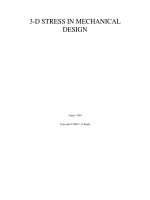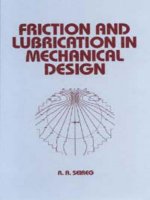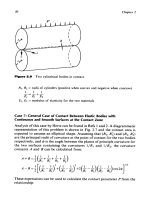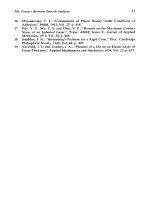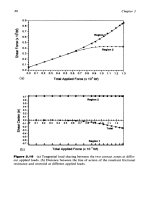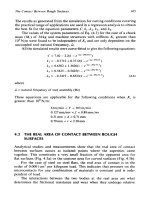Tài liệu Friction and Lubrication in Mechanical Design P1 pdf
Bạn đang xem bản rút gọn của tài liệu. Xem và tải ngay bản đầy đủ của tài liệu tại đây (1.83 MB, 40 trang )
FRICTION RND
LUBRIC~llON
IN
MKHRNICRL
D€SIGN
MECHANICAL ENGINEERING
A Series of Textbooks and Reference Books
Editor
L. L. Faulkner
Columbus Division, Battelle Memorial Institute
and Department of Mechanical Engineering
The Ohio State University
Colurnbus, Ohio
1.
2.
3.
4.
5.
6.
7.
8.
9.
10.
1 1.
12.
13.
14.
15.
1 6.
17.
18.
19.
20.
21
.
22.
23.
Spring Designer's Handbook, Harold Carlson
Computer-Aided Graphics and Design, Daniel L. Ryan
lubrication Fundamentals, J. George Wills
Solar Engineering for Domestic Buildings, William A. Himmelman
Applied Engineering Mechanics: Statics and Dynamics, G. Boothroyd and
C. Poli
Centrifugal Pump Clinic, lgor J . Karassik
Computer-Aided Kinetics for Machine Design, Daniel L. Ryan
Plastics Products Design Handbook, Part A: Materials and Components;
Part B: Processes and Design for Processes, edited by Edward Miller
Turbomachinery: Basic Theory and Applications, Earl Logan, Jr.
Vibrations o f Shells and Plates, Werner Soedel
Flat and Corrugated Diaphragm Design Handbook, Mario Di Giovanni
Practical Stress Analysis in Enginee~ng
Design, Alexander Blake
An Introduction to the Design and Behavior of Bolted Joints, John H .
Bickford
Optimal Engineeing Dmgn: pn'nc@lesand Applications, James N. Siddall
Spring Manufacturing Handbook, Harold Carlson
Industrial Noise Control: Fundamentals and Applications, edited by Lewis
H. Bell
Gears and Their Vibration: A Basic Approach to Understanding Gear
Noise, J . Derek Smith
Chains for Power Transmission and Material Handling: Design and Applications Handbook, American Chain Association
Corrosion and Corrosion Protection Handbook, edited by Philip A.
Schweitzer
Gear Drive Systems: Design and Application, Peter Lynwander
Controlhg In-Plant Airborne Contaminants: Systems Design and Calculations, John D. Constance
CAD/CAM Systems Planning and Implementation, Charles S. Knox
Probabilistic Engineering Design: Princbles and Applications, Jarnes N.
Siddall
24. Traction Drives: Selection and Application, Frederick W. Heilich 111 and
Eugene E. Shube
25. Finite Element Methods: An Introduction, Ronald L. Huston and Chris E.
Passerello
26. Mechanical Fastening of plastics: An Engineen'ng Handbook, Brayton Lincoln, Kenneth J. Gomes, and James F. Braden
27. Lubrication in Practice: Second Edition, edited by W. S. Robertson
28. Princ@lesof Automated Drafting, Daniel L. Ryan
29. Practical Seal Design, edited by Leonard J. Martini
30. Engineering Documentation for CAD/CAM Applications, Charles S. Knox
3 1. Design Dimensioning with Computer Graphics Applications, Jerome C.
Lange
32. Mechanism Analysis: Simplified Graphical and Analytical Techniques, Lyndon 0 . Barton
33. CAD/CAM Systems: Justification, Implementation, Productivity Measurement, Edward J. Preston, George W. Crawford, and Mark E. Coticchia
34. Steam Plant Calculations Manual, V . Ganapathy
35. Design Assurance for Engineers and Managers, John A. Burgess
36. Heat Transfer Fluids and Systems for Process and Energy Applications,
Jasbir Singh
37. Potential Flows: Computer Graphic Solutions, Robert H. Kirchhoff
38. Computer-Aided Graphics and Design: Second Edition, Daniel L. Ryan
39. Electronically Controlled Proportional Valves: Selection and Application,
Michael J. Tonyan, edited by Tobi Goldoftas
40. Pressure Gauge Handbook, AMETEK, U.S. Gauge Division, edited by Philip W. Harland
41. Fabric Filtration for Combustion Sources: Fundamentals and Basic Technology, R. P. Donovan
42. Design of Mechanical Joints, Alexander Blake
43. CAD/CAM Dictionary, Edward J. Preston, George W. Crawford, and
Mark E. Coticchia
44. Machinery Adhesives for Locking, Retaining, and Sealing, Girard S. Haviland
45. Couplings and Joints: Design, Selection, and Application, Jon R. Mancuso
46. Shaft Alignment Handbook, John Piotrowski
47. BASIC Programs for Steam Plant Engineers: Boilers, Combustion, Fluid
Flow, and Heat Transfer, V. Ganapathy
48. Solving Mechanical Design Problems with Computer Graphics, Jerome C .
Lange
49. Plastics Gearing: Selection and Application, Clifford E. Adams
50. Clutches and Brakes: Design and Selection, William C. Orthwein
5 1. Transducers in Mechanical and Electronic Design, Harry L. Trietley
52. Metallurgical Applications of Shock-Wave and High-Strain-Rate Phenomena, edited by Lawrence E. Murr, Karl P. Staudhammer, and Marc A.
Meyers
53. Magnesium Products Design, Robert S. Busk
54. How to Integrate CAD/CAM Systems: Management and Technology, William D. Engelke
55. Cam Design and Manufacture: Second Edition; with cam design software
for the IBM PC and compatibles, disk included, Preben W. Jensen
56. Solid-state A C Motor Controls: Selection and Application, Sylvester Campbell
57. Fundamentals of Robotics, David D. Ardayfio
50. Belt Selection and Application for Engineers, edited by Wallace D. Erickson
59. Developing Three-Dimensional CAD Software with the IBM PC, C. Stan
Wei
60. Organizing Data for CIM Applications, Charles S. Knox, with contributions by Thomas C. Boos, Ross S. Culverhouse, and Paul F. Muchnicki
61. Computer-Aided Simulation in Railway Dynamics, by Rao V. Dukkipati
and Joseph R. Amyot
62. Fiber-Reinforced Composites: Materials, Manufacturing, and Design, P. K.
Mallick
63. Photoelectric Sensors and Controls Selection and Application, Scott M.
Juds
64. Finite Element Analysis with Personal Computers, Edward R. Champion,
Jr., and J. Michael Ensminger
65. Ultrasonics: Fundamentals, Technology, Applications: Second Edition,
Revised and Expanded, Dale Ensminger
66. Applied Finite Element Modeling: Practical Problem Solving for Engineers,
Jeffrey M. Steele
67. Measurement and Instrumentation in Engineering: Princ@les and Basic
Laboratory Experiments, Francis S. Tse and lvan E. Morse
60. Centrifugal Pump Clinic: Second Edition, Revised and Expanded, lgor J.
Karassik
69. Practical Stress Analysis in Engineering Design: Second Edition, Revised
and Expanded, Alexander Blake
70. An Introduction to the Design and Behavior of Bolted Joints: Second
Edition, Revised and Expanded, John H. Bickford
71. High Vacuum Technology: A Practical Guide, Marsbed H. Hablanian
72. Pressure Sensors: Selection and Application, Duane Tandeske
73. Zinc Handbook: Properties, Processing, and Use in Design, Frank Porter
74. Thermal Fatigue of Metals, Andrzej Weronski and Tadeusz Hejwowski
75. Classical and Modern Mechanisms for Engineers and Inventors, Preben
W. Jensen
76. Handbook o f Electronic Package Design, edited by Michael Pecht
77. Shock-Wave and High-Strain-Rate Phenomena in Materials, edited by
Marc A. Meyers, Lawrence E. Murr, and Karl P. Staudhammer
70. Industrial Refrigeration: Princ@les, Design and Applications, P. C. Koelet
79. Applied Combustion, Eugene L. Keating
80. Engine Oils and Automotive Lubrication, edited by Wilfried J. Bartz
0 1 . Mechanism Analysis: Simplified and Graphical Techniques, Second Edition,
Revised and Expanded, Lyndon 0 . Barton
02. Fundamental Fluid Mechanics for the Practicing Engineer, James W.
Murdock
03. fiber-Reinforced Composites: Materials, Manufacturing, and Design, Second Edition, Revised and Expanded, P. K. Mallick
84. NumericalMethods for Engineen'ng Applications, Edward R. Champion, Jr.
85. Turbomachinery: Basic Theory and Applications, Second Edition, Revised
and Expanded, Earl Logan, Jr.
86. Vibrations of Shells and Plates: Second Edition, Revised and Expanded,
Werner Soedel
87. Steam Plant Calculations Manual: Second Edition, Revised and Ex
panded, V. Ganapathy
88. Industrial Noise Control: Fundamentals and Applications, Second Edition,
Revised and Expanded, Lewis H. Bell and Douglas H. Bell
89. finite Elements: Their Design and Performance, Richard H. MacNeal
90. Mechanical Properties of Polymers and Composites: Second Edition, Revised and Expanded, Lawrence E. Nielsen and Robert F. Landel
91. Mechanical Wear Prediction and Prevention, Raymond G. Bayer
92. Mechanical Po wer Transmission Components, edited by David W. South
and Jon R. Mancuso
93. Handbook of Turbomachinery, edited by Earl Logan, Jr.
94. Engineering Documentation Control Practices and Procedures, Ray E.
Monahan
95. Refractory Linings Thermomechanical Design and Applications, Charles
A. Schacht
96. Geometric Dimensioning and Tolerancing: Applications and Techniques
for Use in Design, Manufactun'ng, and Inspection, James D. Meadows
97. An Introduction to the Design and Behavior of Bolted Joints: Third Edition, Revised and Expanded, John H . Bickford
98. Shaft Alignment Handbook: Second Edition, Revised and Expanded, John
Piotrowski
99. Computer-Aided Design o f Polymer-Matrix Composite Structures, edited
by Suong Van Hoa
100. Friction Science and Technology, Peter J . Blau
101. Introduction to Plastics and Composites: Mechanical Properties and Engineering Applications, Edward Miller
102. Practical Fracture Mechanics in Design, Alexander Blake
103. Pump Characteristics and Applications, Michael W. Volk
104. Optical Princr;Oles and Technology for Engineers, James E. Stewart
105. Optimizing the Shape of Mechanical Elements and Structures, A. A.
Seireg and Jorge Rodriguez
106. Kinematics and Dynamics of Machinery, Vladimlr Stejskal and Michael
Val4Sek
107. Shaft Seals for Dynamic Applications, Les Horve
108. Reliability-BasedMechanical Design, edited by Thomas A. Cruse
109. Mechanical Fastening, Joining, and Assembly, James A. Speck
110. Turbomachinery Fluid Dynamics and Heat Transfer, edited by Chunill Hah
111. High- Vacuum Technology: A Practical Guide, Second Edition, Revised
and Expanded, Marsbed H. Hablanian
112. Geometric Dimensioning and Tolerancing: Workbook and Ans werbook,
Jarnes D. Meadows
113. Handbook of Materials Selection for Engineering Applications, edited by
G. T. Murray
1 14. Handbook of Thermoplastic Ptping System Design, Thomas Sixsmith and
Reinhard Hanselka
1 15. Practical Guide to Finite Elements: A Solid Mechanics Approach, Steven
M. Lepi
1 16. Applied ComputationalFluid Dynamics, edited by Vijay K. Garg
1 1 7 . Fluid Sealing Technology, Heinz K. Muller and Bernard S. Nau
1 18. Friction and Lubrication in Mechanical Design, A. A. Seireg
Additional Volumes in Preparation
Machining of Ceramics and Composites, edited by Said Jahanmir, M.
Ramulu, and Philip Koshy
Heat Exchange Design Handbook, T . Kuppan
Couplings and Joints: Second Edition, Revised and Expanded, Jon R.
Mancuso
Mechanical EngineeringSoftware
Spring Design with an IBM PC, AI Dietrich
Mechanical Design Failure Analysis: With Failure Analysis System Software for the IBM PC, David G. Ullman
Influence Functions and Matrices, Yuri A. Melnikov
FRICT'IONR"
LUBRIC~ION
IN
M€CHANI(RL
D€SIGN
University of Wisconsin-Madison
Madison, Wisconsin
and University of Florida
Gainesviiie, Florida
a%
MARCEL
DEKKER
MARCEL
DEKKER,
INC.
NEW
YORK BASEL HONG
KONG
ISBN: 0-8247-9974-7
This book is printed on acid-free paper.
Headquarters
Marcel Dekker, Inc.
270 Madison Avenue, New York, NY 10016
tel: 2 12-696-9000; f a : 2 12-685-4540
Eastern Hemisphere Distribution
Marcel Dekker AG
Hutgasse 4, Postfach 812, CH-4001 Basel, Switzerland
tel: 44-6 1-26 1-8482; f a : 44-6 1-26 1-8896
World Wide Web
The publisher offers discounts on this book when ordered in bulk quantities. For more information, write to Special Saleflrofessional Marketing at the headquarters address above.
Copyright 0 1998 by Marcel Dekker, Inc. All Rights Reserved.
Neither this book nor any part may be reproduced or transmitted in any form or by any
means, electronic or mechanical, including photocopying, microfilming, and recording, or
by any information storage and retrieval system, without permission in writing from the
publisher.
Current printing (last digit):
1 0 9 8 7 6 5 4 3 2 1
PRINTED IN THE UNITED STATES OF AMERICA
Preface
The awareness of friction and attempts to reduce or use it are as old as
human history. Scientific study of the friction phenomenon dates back to the
eighteenth century and has received special attention in modern times since
it is one of the most critical factors in all machinery. The increasing emphasis on material and energy conservation in recent years has added new
urgency to the development of practical predictive techniques and information that can be used, in the design stage, for controlling friction and wear.
Advances in this field continue to contribute to improved energy efficiency,
increased useful life of machines, and reduced maintenance costs.
This book treats friction, lubrication, and wear as empirical phenomena
and relies heavily on the experimental studies by the author and his
coworkers to develop practical tools for design. Empirical dimensionless
relationships are presented, whenever possible, that can be readily applied
to a variety of situations confronting the design engineer without the need
for extensive theoretical analysis or computation.
The material in the book has been used for many years in an interdisciplinary course on this subject taught at the University of WisconsinMadison, and can be used as a text for senior, graduate, or professional
development courses. It can also be used as a reference book for practical
design engineers because the many empirical equations and design graphs
can provide a fundamental parametric understanding to guide their design
decisions.
Chapter 1 gives a brief review of the history of this subject and sets the
stage for the topics presented in the book. Chapters 2, 3, and 4 summarize
...
111
iv
Preface
the relevant relationships necessary for the analysis of contact mechanics in
smooth and rough surfaces, as well as the evaluation of the distribution of
the frictional resistance over the contacting surfaces due to the application
of tangential loads and twisting moments.
Chapter 5 presents an overview of the mechanism of the transfer of
frictional heat between rubbing surfaces and gives equations for estimating
the heat partition and the maximum temperature in the contact zone.
Chapter 6 deals with the broad aspects of fluid film lubrication with
emphasis on the thermal aspects of the problem. It introduces the concept
of thermal expansion across the film and provides a method for calculating
the pressure that can be generated between parallel surfaces as a result of
the thermal gradients in the film. Chapter 7 discusses the problem of
friction and lubrication in rolling/sliding contacts and gives empirical
equations for calculating the coefficient of friction from the condition of
pure rolling to high slide-to-roll ratios. The effect of surface layers is taken
into consideration in the analysis. Chapter 8 gives an overview of the
different wear mechanisms and includes equations to help the designer
avoid unacceptable wear damage under different operating and environmental conditions. Chapter 9 presents selected case illustrations and corresponding empirical equations relating the factors influencing surface
durability in important tribological systems such as gears, bearings,
brakes, fluid jet cutting, soil cutting, one-dimensional clutches, and animal
joints.
Chapter 10 discusses the frictional resistance in micromechanisms.
Friction is considered a major factor in their implementation and successful
operation. Chapter 11 illustrates the role of friction in the generation of
noise in mechanical systems, and Chapter 12 gives an introduction to surface coating technology, an area of growing interest to tribologists.
Finally, Chapter 13 discusses in some detail a number of experimental
techniques developed by the author and his coworkers that can be useful in
the study of friction, lubrication, wear, surface temperature, and thermally
induced surface damage.
I am indebted to my former students, whose thesis research constitutes
the bulk of the material in this book. Dr. T. F. Conry for his contribution to
Chapter 2; Dr. D. Choi to Chapter 3; Dr. M. Rashid to Chapter 5; Drs. H.
Ezzat, S. Dandage, and N.Z. Wang to Chapter 6; Dr. Y. Lin to Chapter 7;
Dr. T. F. Conry, Mr. T. Lin, Mr. A. Suzuki, Dr. A. Elbella, Dr. S. Yu, Dr.
A. Kotb, Mr. M. Gerath, and Dr. C. T. Chang to Chapter 9; Dr. R. Ghodssi
to Chapter 10; Drs. S . A. Aziz and M. Othman to Chapter 11; Dr. K.
Stanfill, Mr. M. Unee, and Mr. T. Hartzell to Chapter 12; and Professor
E. J. Weiter, Dr. N. Z. Wang, Dr. E. Hsue, and Mr. C. Wang to Chapter 13.
Preface
V
Grateful acknowledgment is also due to Ms. Mary Poupore, who
efficiently took charge of typing the text, and to Mr. Joe Lacey, who
took upon himself the enormous task of digitizing the numerous illustrations in this book.
A . A . Seireg
This page intentionally left blank
Contents
Preface
Unit Conversion Table
1 Introduction
1.1 Historical Overview
1.2 Theories of Dry Friction
1.3 Boundary Lubrication Friction
1.4 Friction in Fluid Film Lubrication
1.5 Frictional Resistance in Elastohydrodynamic Contacts
References
...
111
xi
1
1
4
7
9
14
17
22
2 The Contact Between Smooth Surfaces
2.1 Introduction
2.2 Design Relationships for Elastic Bodies in Contact
2.3 A Mathematical Programming Method for Analysis
and Design of Elastic Bodies in Contact
2.4 A General Method of Solution by a Simplex-Type
Algorithm
2.5 The Design Procedure for Uniform Load Distribution
References
40
3 Traction Distribution and Microslip in Frictional Contacts
Between Smooth Elastic Bodies
3.1 Introduction
56
22
22
43
46
53
56
vii
Contents
viii
Traction Distribution, Compliance, and Energy
Dissipation in Hertzian Contacts
3.3 Algorithmic Solution for Traction Distribution
Over Contact Area With Arbitrary Geometry Subjected
to Tangential Loading Below Gross Slip
3.4 Frictional Contacts Subjected to a Twisting Moment
3.5 Frictional Contacts Subjected to a Combination of
Tangential Force and Twisting Moment
References
3.2
57
62
76
90
97
4 The Contact Between Rough Surfaces
4.1 Surface Roughness
4.2 Surface Roughness Generation
4.3 The Real Area of Contact Between Rough Surfaces
4.4 The Interaction Between Rough Surfaces During
Relative Motion
4.5 A Model for the Molecular Resistance
4.6 A Model for the Mechanical Resistance
4.7 Friction and Shear
4.8 Relative Penetration Depth as a Criterion for the
Contact Condition
4.9 Effect of Sliding on the Contacting Surfaces
References
100
100
100
105
5 Thermal Considerations in Tribology
5.1 Introduction
5.2 Thermal Environment in Frictional Contact
5.3 An Introductory Treatment of Transient Heat Transfer
5.4 Temperature Rise Due to Heat Input
5.5 Heat Partition and Transient Temperature Distribution
in Layered Lubricated Contacts
5.6 Dimensionless Relationships for Transient Temperature
and Heat Partition
References
121
121
121
123
127
6 Design of Fluid Film Bearings
6.1 Hydrodynamic Journal Bearings
6.2 Design Systems
6.3 Thermodynamic Effects on Bearing Performance
6.4 Thermohydrodynamic Lubrication Analysis
161
161
187
209
Incorporating Thermal Expansion Across the Film
References
111
113
113
114
115
116
118
135
142
158
230
246
ix
Contents
7 Friction and Lubrication in Rolling/Sliding Contacts
7.1 Rolling Friction
7.2 Hydrodynamic Lubrication and Friction
7.3 Elastohydrodynamics in Rolling/Sliding Contacts
7.4 Friction in the Elastohydrodynamic Regime
7.5 Domains of Friction in EHD Rolling/Sliding
Contacts
7.6 Experimental Evaluation of the Frictional Coefficient
7.7 The Empirical Formulas
7.8 Procedures for Calculation of the Coefficient of Friction
7.9 Some Numerical Results
References
251
25 1
252
253
256
260
264
270
300
304
307
8 Wear
8.1 Introduction
8.2 Classification of Wear Mechanisms
8.3 Frictional Wear
8.4 Wear Due to Surface Fatigue
8.5 Wear by Microcutting
8.6 Thermal Wear
8.7 Delamination Wear
8.8 Abrasive Wear
8.9 Corrosive Wear
8.10 Fretting Corrosion
8.1 1 Cavitation Wear
8.12 Erosive Wear
References
310
3 10
9 Case
9.1
9.2
9.3
9.4
9.5
9.6
9.7
339
Illustrations of Surface Damage
Surface Failure in Gears
Rolling Element Bearings
Surface Temperature, Thermal Stress, and Wear in Brakes
Water Jet Cutting as an Application of Erosion Wear
Frictional Resistance in Soil Under Vibration
Wear in Animal Joints
Heat Generation and Surface Durability of
RampBall Clutches
References
10 Friction in Micromechanisms
10.1 Introduction
10.2 Static Friction
31 1
312
317
327
328
332
332
333
333
334
335
336
339
349
360
368
376
377
387
404
411
41 1
412
Contents
10.3
Rolling Friction
References
414
42 1
11 Friction-Induced Sound and Vibration
11.1 Introduction
11.2 Frictional Noise Due to Rubbing
11.3 Effect of Lubrication on Noise Reduction
11.4 Frictional Noise in Gears
1 1.5 Friction-Induced Vibration and Noise
1 1.6 Procedure for Determination of the Frictional
Properties Under Reciprocating Sliding Motion
References
423
423
423
430
432
437
12 Surface Coating
12.1 Introduction
12.2 Coating Processes
12.3 Types of Coatings
12.4 Diamond Surface Coatings
12.5 Failure Mechanisms of Surface Coatings
12.6 Typical Applications of Surface Coatings
12.7 Simplified Method for Calculating the Maximum
Temperature Rise in a Coated Solid Due to a Moving
Heat Source
12.8 Thermal Stress Considerations
References
453
453
453
458
466
470
47 1
44 1
45 1
473
482
48 5
13 Some Experimental Studies in Friction, Lubrication, Wear, and
Thermal Shock
13.1 Frictional Interface Behavior Under Sinusoidal
Force Excitation
13.2 Friction Under Impulsive Loading
13.3 Viscoelastic Behavior of Frictional Hertzian Contacts
Under Ramp-Type Loads
13.4 Film Pressure in Reciprocating Slider Bearings
13.5 Effect of Lubricant Properties on Temperature and
Wear in Sliding Concentrated Contacts
13.6 The Effect of Repeated Thermal Shock on Bending
Fatigue of Steel
References
Author Index
Subject Index
488
488
497
506
515
519
527
533
537
545
Unit Conversion Table
1 inch = 25.4mm = 2.54cm = 0.0254 meter [m]
1 foot = 0.3048m
1 mile = 1609 m = 1.609 km
1 lb = 4.48 newton [NI = 0.455 kg
1 lb-ft (moment) = 1.356 N-m
I lb-ft (work) = 1.356 joule [J]
1 lb-ft/sec = 1/356 watt [W]
1 hp = 0.746kW
1 lb/in2 (psi) = 6895 pascal [Pal
1 Btu = 1055 joule [J]
1 centipoise = 0.001 pascal-second [Pa-s]
Degree F = degree C x ( 9 / 5 ) 32
1 gallon = 3.785 liters = 0.003785m3
1 quart = 0.946 liter
+
xi
This page intentionally left blank
FRICTION R"
LUBRICRTION IN
M€CHRNlCRL
D€SIGN
This page intentionally left blank
A
Introduction
1.1
HISTORICAL OVERVIEW
The phenomenon of friction has been part of daily life since the beginning of
human existence. It is no surprise that some of the earliest human activities
involved the reduction of friction when it was wasteful, or the use of friction
when it could be beneficial. The first category includes the use of vegetable
oils and animal fats as lubricants, as well as the use of rolling motion to take
advantage of the resulting low resistance to movement. The second category
can be exemplified by the rubbing of twigs to start a fire and the control of
motion by braking action.
In most situations, friction is an undesirable phenomenon that should
be minimized. It results in hindering movement, wasting effort, generating
unwanted heat, and causing wear and damage to the contacting surfaces. It
is, however, hard to imagine the world without friction. In a frictionless
environment there will be no tractive forces to allow locomotion, gripping,
braking, fastening, weaving, and many other situations which are fundamental to human life.
The earliest recorded attempt to reduce friction can be traced back to
the 20th century B.C. as illustrated by the temple painting, Figure 1.1,
showing a man pouring oil to facilitate the movement of a colossus.
Evidence of the use of animal fat on the axles of chariots has also been
discovered in Egyptian tombs dating back to the 15th century B.C.
Themistius (390-320 B.C.) observed that rolling friction is much smaller
than sliding friction. This is what made the wheel the first major advance in
the field of ground transportation.
I
Figure 1.1 An ancient record dating back to 1900 B.C. showing the use of lubricating oil to reduce friction in moving a colossus.
I t was not until the middle ages that Leonardo da Vinci (1452-1519)
formulated his basic laws of friction. which provide a predictive rationak
for evaluating frictional resistance. He stated that frictional forces are proportional to weight and are independent of the area of contact [I].
Guillaume Aniontons ( 1 663-1 705) in a paper published in the proceedings of the French Royal Academy of Sciences [ 2 ] , rediscovered the frictional laws originally proposed by Leonardo da Vinci. The fact that the
frictional force was proportional to the normal load was readiiy accepted
by the academy. but the independence of friction on the area of contact was
received with skepticism. The senior academician De La Hire (164G1718)
went on to check Amontons' second law and did confirm its validity.
An interesting observation was advanced by John Desaguliers (1683f 744) who pointed out in his book on experimental philosophy, published in
1734. that the frictional resistance between flat metallic bodies may increase
as a result of polishing the contacting surfaces. He attributed this to
adhesive forces which he calIed "cohesion." He recognized that such forces
exist, but he could not formulate means of accounting for them.
Charles Augustin Coulomb ( 1736-1 806) is generally regarded as the
founder of the frictional laws. His understanding of the causes of friction,
however, was not completely clear. He recognized the importance of roughness and suggested that friction was due to the work done in dragging one
surface up the other. One of the important contributions of Coulomb is his
postulation that contact only occurs at the discrete points of asperity contacts. However, he rejected the adhesion theory and reasoned that if adhesion exists, the frictional resistance has to be doubled if the area of contact
Introduction
3
is doubled. He consequently believed that frictional resistance is due to the
work done in moving one surface up the roughness of the other [3].
John Leslie (1766-1832) criticized both the roughness and adhesion
theories and believed that friction was due to the work done by deformation
of the surface due to roughness. Although these early investigations alluded
to the possible mechanism of friction, it took over a century of research to
conclude that friction between solids arises from their interaction at the
regions where they are in real contact. This is influenced by the geometry
of the surfaces, their elastic properties, the adhesive forces at the real contacts and how energy is lost when the surfaces are deformed during sliding.
Friction is generally divided into four regimes: dry, boundary, elastohydrodynamic, and hydrodynamic. In dry friction, surface cleanliness is one
of the most important factors influencing the frictional resistance. Even a
single molecular layer of grease from the atmosphere or from the fingers
may change the coefficient of friction significantly. The influence of surface
cleanness is much greater than that of surface roughness. On the other
extreme, when the surfaces are separated by a thick film of lubricant, the
resistance to movement is determined by the dynamic behavior of the film.
Osborne Reynolds (1842-1912) developed in 1886 the fundamental
basis for the hydrodynamic lubrication theory and the frictional resistance
[4]. In this case there is no metal-to-metal contact and friction is a result of
the shear resistance as influenced by the viscosity of the lubricant and the
thickness of the film. Reynolds’ analysis was inspired by the experimental
findings of Petrov (1836-1920) and Tower (1845-1904). Petrov reported in
1883 [5] that viscosity is the most important fluid property in film lubrication, and not density as previously thought. He also concluded that frictional losses in full film lubrication are the result of viscous shearing of the
film.
The experimental studies published by Tower in 1883 and 1885 [6, 71
showed that the load carrying ability of a bearing partially submerged in an
oil bath is the result of the high pressures developed in the clearance space
between the journal and the sleeve and that the clearance is an essential
parameter in achieving full film lubrication and consequently reducing friction in the bearing.
In lubricated concentrated contacts, the pressure in the fluid is usually
sufficiently high to deform the solid surfaces. This condition exists in many
machine elements such as gears, rolling element bearings, cams and automotive tires on roads covered with water. The analysis of this elastohydrodynamic phenomenon was first investigated by Grubin [8] and Dowson [9,
101 and constitutes an important field of tribology. Both hydrodynamic and
elastohydrodynamic friction are highly dependent on speed and the viscosity
of the fluid. For low speeds or low viscosity fluids when the lubricating fluid
4
Chapter I
film is not sufficiently thick to separate the asperities on the surface of the
contacting solids, the frictional resistance will be much higher than that with
full film lubrication but appreciably lower than that for dry surfaces. An
early investigation of friction in this regime, which is called boundary lubrication, was undertaken by Sir William Hardy in the early 1920s. His study
showed that frictional resistance in the boundary regime is proportional to
the normal load. The main advantage of boundary lubrication is to generate
a thin fluid film on the surface which reduces the solid-to-solid contacts and
consequently reduces friction, wear, and noise [ 1 1 , 121.
Scientific study of the friction, lubrication, and wear phenomena in all
these regimes is now receiving considerable attention in modern engineering.
Friction is a primary cause of energy dissipation, and considerable economic
savings can be made by better understanding of its mechanism and its control. The operation of most modern engineering systems such as machines,
instruments, vehicles and computer hardware, etc. is influenced by the
occurrence of friction in some form or another.
Tribology, which is the name currently used to encompass the multitude
of activities in this highly interdisciplinary subject, is now attaining a prominent place among the sciences [ 131. It continues to present challenges for
those who are working in it in response to the ever increasing interest of the
mechanical and electronic industries to learn more about the causes of the
energy losses due to friction and wear [14]. The enormous energy loss in
tribological sinks in the United States is estimated by experts to be $20
billion in 1998.
The emerging technology of micromechanisms is placing new emphasis
on tribology on the microscale [15, 161. Because of their very large surface
area to volume ratios, adhesion, friction, surface tension, viscous resistance,
and other boundary forces will be the dominant factors which control their
design and performance characteristics. Not since the middle ages have
tribologists been confronted with new frontiers of such proportions and
without precedence in human experience. New challenges are now presenting themselves on how to model, predict, and measure these forces.
Understanding friction on the microscale will be the most critical element
in the useful utilization of micromechanisms.
1.2
THEORIES O D Y FRICTION
F R
The classical theory of dry friction has been discussed by many workers
(e.g., Moore [17] and Rabinowicz [IS]). The classical friction laws can be
summarized as follows:

